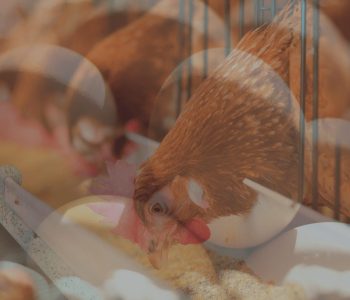Copper and its functions in the diet of laying hens: advantages of the chelated form
The use of organic minerals such as copper has generated great interest in laying hen production, as it is essential for egg and bone formation, structural tissue integrity, protection against oxidation, and the development of the immune response.
The main functions include acting as a cofactor in enzymes involved in cellular energy production (cytochrome-C oxidase), detoxification of free radicals (copper-zinc superoxide dismutase or SOD), connective tissue formation (via lysyl oxidase), iron mobilization (via ceruloplasmin), and neurotransmission (mediated by dopamine β-hydroxylase) (Suttle, 2010).
Copper has been studied for a long time, and its characteristic as an essential micromineral for metabolism was cited in 1928 by Hart and Elvehjem, who, through studies with rats, found that copper is essential for growth, hemoglobin formation, as well as for the prevention of a variety of clinical and pathological disorders related to its deficiency, such as anemia (McDonald, 2006).
| Therefore, copper supplementation in diets is necessary, since plant-based ingredients used in the formulation of balanced poultry feeds, despite having high concentrations, have low availability. |
| Copper toxicity in hens can cause diarrhea, weight loss, lethargy, and in severe cases, death. There may also be changes in feces color, damage to the liver and kidneys, and a decrease in egg production and quality. |
Copper deficiency can cause anemia, reduced egg-laying rate, and poorer eggshell quality. It can also lead to slow growth rate and lower body weight, damage to the structure and function of the kidneys and liver, and changes in feather pigmentation (Schlegel, 2017).
Copper supplementation in the diet of laying hens can be done through inorganic and organic sources.
Inorganic microminerals exist in their elemental form or in simple forms, such as inorganic salts. These minerals do not contain carbon and are usually added in the form of salts.
The other way to supplement is through organic microminerals. An organic mineral is a different form where the essential inorganic mineral is bound (chelated) to an organic molecule.
The bond results in a stable complex where the mineral is protected by the organic molecule during digestion and absorption in the gastrointestinal tract.
This increases the bioavailability of the mineral, meaning it improves the organism’s ability to absorb and utilize the mineral more efficiently.
Organic bonding can be done with amino acids (glycine, lysine, methionine), proteins (casein), yeasts (Saccharomyces cerevisiae), or organic acids (citric and malic acid).
The replacement of inorganic minerals with organic minerals is becoming increasingly common in the formulation of supplements for laying hens due to its benefits, which include:
- Better absorption: Chelation improves the bioavailability of minerals, allowing for more efficient absorption in the gastrointestinal tract, which means that the supplemented amount can be lower.
- Reduced interaction with other nutrients: Chelated minerals are less likely to negatively interact with other nutrients, which can sometimes occur with inorganic forms.
- Reduce the risk of toxicity: Chelation can reduce the potential for mineral toxicity by helping to control the gradual release and absorption of minerals.
- Stability and safety: Chelated complexes are more stable and less likely to degrade or precipitate during storage or within the digestive tract.
- Lower gastrointestinal irritation: Some chelated minerals are less likely to cause irritation in the stomach and intestines compared to their inorganic counterparts.
The growing interest in using organic copper in diets for production animals, especially poultry, stems from the fact that inorganic copper often becomes unavailable for absorption. This unavailability happens because it gets sequestered by compounds like phytate, and due to competition among trace minerals for certain transporters.
Thanks to the benefits of chelation, when working with organic copper for laying hens, it is possible to supplement in smaller amounts than those established by standard requirements without compromising performance or egg quality.
Studies show that organic copper supplementation provides positive effects for commercial laying hens and broiler breeders. The main benefits include:
| The essential effects are: improvement of eggshell strength and performance, enhancement of both internal and external egg quality, reduction of excretion into the environment, increase in antioxidant capacity, and modulation of genes involved in the formation of the organic matrix in the eggshell gland (Passos, 2010; Dong et al., 2022; Qiu et al., 2020; Yaqoob et al., 2020). |
| In heavy breeder hens during the peak laying period, an improvement in egg quality and hepatic antioxidant status was observed (Yaqoob, 2020). In commercial laying hens at the end of the production cycle, there was an increase in eggshell thickness and strength, an improvement in eggshell ultrastructure, increased mineral deposition in the shell, enhanced antioxidant capacity and immune function, and a reduction in mineral excretion in the feces (Zhang, 2021). |
| Additionally, copper plays a role in bone formation as it acts as an activator of lysyl oxidase, an enzyme involved in collagen biosynthesis (Pophal and Suida, 2007). |
Therefore, the use of organic copper is an interesting nutritional strategy in the feeding of laying hens, as its application improves production indices without compromising egg performance and quality, while also reducing the excretion of the element into the environment.
